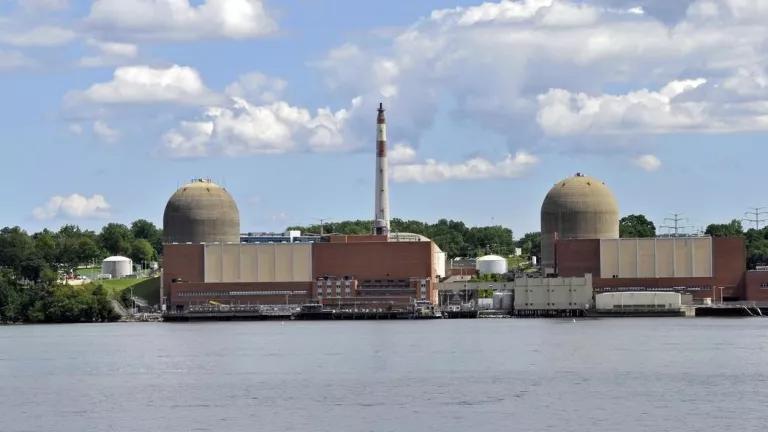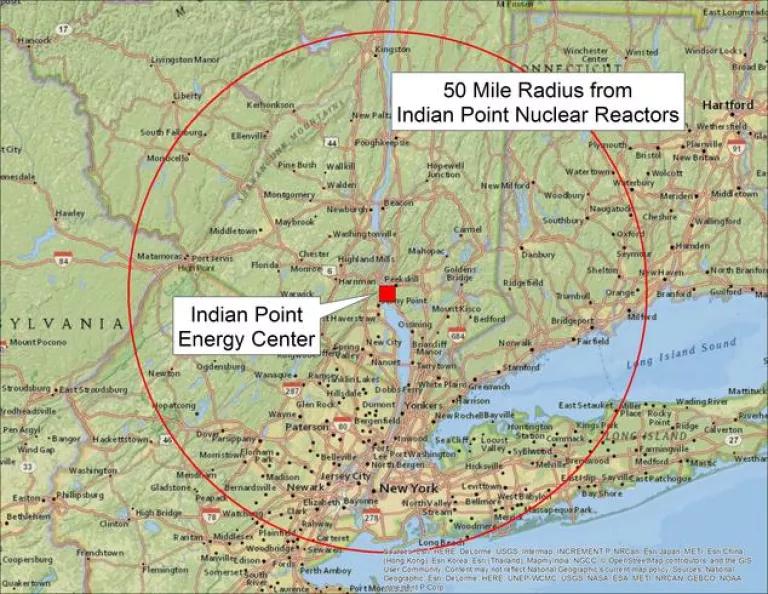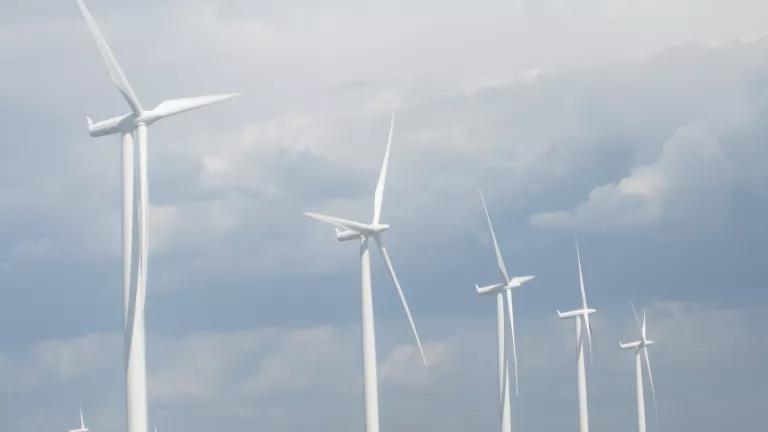New York Begins to Move Beyond Indian Point

This blog is dedicated to the memory of former New York State Assembly Member Richard Brodsky (May 4, 1946 - April 8, 2020). Richard was an environmental champion par excellence and a tireless advocate for the closure of Indian Point. He will be deeply missed.
On April 30, 2020, New York State will mark a major milestone in the fight for public health and the environment when one of two nuclear reactors at the troubled and aging Indian Point nuclear power plant, located 24 miles north of New York City, is permanently shuttered. In January 2017, under a negotiated agreement between New York State, Entergy (the facility’s owner) and the environmental organization Riverkeeper, Governor Cuomo announced that the first Indian Point reactor would close in April 2020 and the second Indian Point reactor would close in April 2021.
The planned, orderly closure of Indian Point is welcome news for the nearly 20 million people living within 50 miles of Indian Point. NRDC has long opposed relicensing its two reactors because of Indian Point’s history of operational, safety, and environmental problems, as well as the grave risk of a nuclear accident so close to the nation’s largest city. Fortunately, the Cuomo administration’s groundbreaking clean energy policies have helped to ease the transition to safer, carbon free alternatives—namely energy efficiency, land-based and offshore wind power, and solar power. As we have done for many years, NRDC will work to ensure that Indian Point’s power is expeditiously replaced with the best mix of clean energy possible.
Indian Point’s Public Health Risks
Indian Point, located in the most densely populated part of our country, presents a unique set of risks. For decades, we’ve heard about one alarming incident after another, including a May 2015 transformer fire which sent thousands of gallons of oil into the Hudson River, radioactive releases into groundwater, failed accident drills, and inadequate disaster planning. The power plant’s two operating units lie within a mile of a significant seismic zone discovered after the plant was built in the 1960s, prompting the Nuclear Regulatory Commission (NRC) to deem Indian Point one of the top ten facilities considered most in need of reevaluation for earthquake vulnerability; one of the 9/11 terrorists had cited the plant as a potential target. Indian Point’s proximity to New York City and the rest of the densely populated tri-state area made potential impacts of an accident severe. My colleague Dr. Matthew McKinzie, a nuclear physicist and director of NRDC’s nuclear team, has blogged about these risks here.

Indian Point’s Closure Won’t Impact Reliability
The New York Independent System Operator (NYISO)—which is charged with ensuring the reliability of New York’s electric grid and running our wholesale electricity markets—noted last year that annual electricity demand in New York State has declined over the last decade after a record high in 2007 and recently predicted that electricity usage will remain essentially flat over the next decade. That’s due in large part to federal, state, and City energy efficiency efforts, including stronger building energy codes and appliance and equipment standards, as well as the aggressive energy efficiency goals that were memorialized in the Climate Leadership and Community Protection Act (CLCPA), New York’s groundbreaking climate legislation enacted last year.
In addition to robust energy efficiency efforts, the state’s rapid deployment of clean, distributed “behind-the-meter” resources like rooftop solar, battery storage and demand response has contributed to a decline in the state’s reliance on bulk system power supply. NYISO further expects that peak electricity demand (the amount of power that we use on the hottest days) will decline slightly over the coming decade, thanks again largely to the state’s clean energy initiatives. And as noted below, the state Public Service Commission has been planning for the facility’s retirement and replacement power needs for some time, even before the closure agreement in 2017. All of this means that it is easier to retire Indian Point today than it might have been a decade ago. Indeed, NYISO’s own analysis concluded Indian Point can retire on schedule without having any impact on the grid’s ability to keep the lights on.
New York Will Meet Its Aggressive Climate Goals Without Indian Point
In announcing Indian Point’s closure in 2017, Governor Cuomo committed that New York’s “leadership on energy and climate change will ensure that Indian Point’s closure will not have an adverse impact on carbon emissions at the regional level. Through the Regional Greenhouse Gas Initiative, the state will continue to drive reductions in greenhouse gases across the power sector.” As outlined below, New York State is poised to meet this commitment.
- RGGI Ensures Regional Emissions Progress: Consistent with Governor Cuomo’s commitment, the Regional Greenhouse Gas Initiative (RGGI)—a multistate effort in the Northeast and Mid-Atlantic to cut power sector carbon pollution—agreed in 2017 to extend the program for another ten years and to strengthen its carbon cap. The RGGI states have committed to cut power plant carbon pollution 65% by 2030 and have already made significant progress toward that goal—emissions have been cut by more than half since the program started in 2009. Significantly, in the modeling that went into charting this carbon trajectory for the program, New York built in an assumption that both Indian Point units would retire in 2019—meaning the projected impacts of this development on regional carbon pollution and allowance prices are essentially already baked in.
- Dirty Peaker Plants Phasing Out: New York State has also taken further steps to reduce other forms of health-harming air pollution from fossil fuel power plants, including the recent adoption of a critical new requirement that imposes a much stricter limit on nitrogen oxide pollution during the summertime, when electricity demand can spike and when air pollution is most deadly. This regulation will importantly begin to shutter the old, dirty peaker plants throughout the state (many of which are located in environmental justice communities) and open up opportunities to replace those facilities with battery storage.
- CLCPA is a Game Changer: New York State has acted aggressively over the last three years to accelerate clean energy progress and is now required to do so by law. The CLCPA mandates that New York State achieve net zero carbon emissions by 2040 and also includes groundbreaking equity provisions to ensure that climate and clean energy benefits are realized by environmental justice communities. This major progress on climate action in New York State was spurred by years of advocacy and activism by the NYRenews coalition and the New York environmental justice community. The CLCPA also includes nation-leading climate and clean energy mandates for solar power, offshore wind, battery storage and energy efficiency. More about the CLCPA is available here.
And so much has been achieved already by New York State in the last decade:
- There are already nearly 1,300 megawatts of demand response (DR) resources (programs that compensate customers for agreeing to cut their electricity use when called upon during high use periods) in place to cut electric power on peak summer days, and there are additional megawatts of retail DR programs approved by the Commission that are operated by utilities like Con Edison.
- New York’s groundbreaking NY-Sun solar power program was launched in 2013 and will continue to scale up solar projects on homes and businesses across the state. NY-Sun has been largely responsible for the incredible growth in solar power throughout New York—nearly 1,800 percent since 2011. The CLCPA ensures that this progress will continue with the mandate to install 6 gigawatts of solar power by 2025.
- New York is also taking bold action to install offshore wind in the waters off New York State. The CLCPA commits the state to building 9 gigawatts of offshore wind power by 2035, a nation-leading mandate. Last year, New York awarded contracts totaling 1.7 GW to several offshore wind projects after a competitive procurement process. And just last week, New York State approved its second offshore wind competitive procurement process for up to 2.5 GW, which will take place later this year.
- Additional transmission capacity is also essential to facilitating the replacement of Indian Point’s power with clean energy. The New York Power Authority has been working to improve reliability and expand capacity on its transmission lines. The fully permitted and approved 1,000 MW TDI Champlain Hudson Power Express transmission project, which would bring low-carbon hydropower from Quebec to New York City, could also play a significant role in replacing Indian Point’s power if it is built.
- New York City is also playing a pivotal role in ramping up energy efficiency and clean energy options. It has already adopted a number of policies to scale up solar through the NYC Solar Partnership, New York City Council legislation, and other initiatives—including easing regulatory obstacles, assistance with collective solar purchasing and shared solar installations, with a goal of 1,000 MW of solar power by 2030. Since 2015, solar PV deployment in New York City has quadrupled, with over 215 MW currently installed. This number is expected to increase significantly given the recently enacted Climate Mobilization Act (CMA), which requires that solar PV systems or green roofs be installed on certain new construction and renovation projects in New York City. Regarding energy efficiency, the City’s leadership role will continue to be critical—with policies building off of its Greener, Greater Buildings Plan expected to continue to reduce energy demand. Local Law 97, a critical piece of the CMA, is one of the most aggressive, wide-reaching laws in the country, as it will significantly reduce carbon emissions from the City’s mid- and large-sized buildings.
Next Steps
Make no mistake, we need to continue to work aggressively to ensure that New York State remains on track to meet its aggressive climate goals, phase out fossil fuels and protect public health and air quality in our communities, with special focus on environmental justice communities. Indeed, we must redouble these efforts.
We also need to ensure that the community around Indian Point and the workers at the plant are supported in the transition to a future without Indian Point. New York State and Entergy have made commitments to the community and plant workers which must be met. In 2015, New York State created a Cessation Mitigation Fund for community mitigation related to power plant close downs. This will be one source of community support once both Indian Point reactors are closed in April 2021.
Finally, we have to meet the challenge of cleaning up the Indian Point site and dealing with the nuclear waste that is currently housed there. Many years will need to be spent decommissioning Indian Point after decades of operation, and New York State and the environmental community need to work hard to ensure a thorough cleanup. And we still have the challenge of the nuclear waste that will remain on site until there is a national solution, but NRDC has charted a course forward to address that issue, with reliance on bedrock environmental laws.
Conclusion
There’s no question that Indian Point was sited in the wrong place some 50 years ago—a location where a severe accident would jeopardize the health of millions of people and where no large-scale evacuation plan would be remotely feasible. Governor Cuomo’s leadership over the past decade helped make Indian Point’s closure a reality. He deserves tremendous credit for his vision and tenacious pursuit of a goal that many dismissed as unachievable. For a decade, the New York Attorney General’s office and the State Department of Environmental Conservation led the charge in opposing the relicensing of Indian Point in the Nuclear Regulatory Commission proceeding and in other related litigation, helping to clear the way to the Indian Point closure agreement. And much credit and thanks go to our colleagues at Riverkeeper and Scenic Hudson, who have been NRDC’s valued allies and determined partners on Indian Point, Hudson River, and clean energy issues for decades. Clearwater and many other local and national groups have also played key roles on these issues over the years. It’s been an honor for NRDC to work with these and many other tireless advocates over the years. Check out the Beyond Indian Point website created by many of these and other activists.
This watershed moment demonstrates just how much can be achieved when we continue to fight for change. Just a decade ago, closing Indian Point seemed a daunting challenge. This week, the closure of the first Indian Point reactor will happen with no red flags from reliability monitors at NYISO, and against the backdrop of accelerated climate and clean energy progress in New York State that was almost unimaginable when we all launched this fight. The closure of the Indian Point Unit 2 this week shows what we can achieve when we dare to take on the biggest energy challenges and apply vision, passion, and skilled advocacy to the task.




